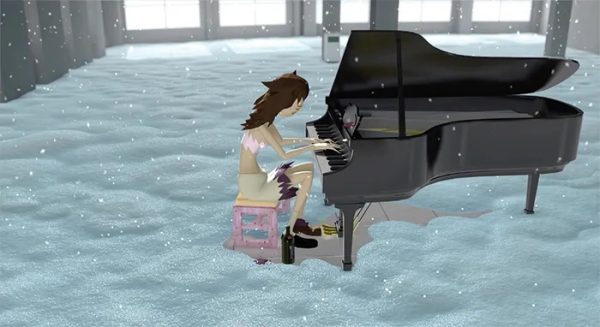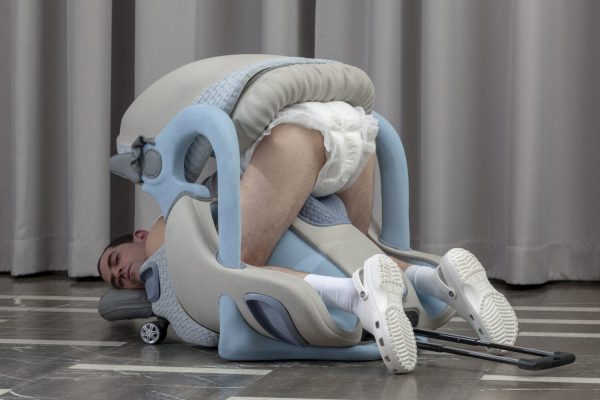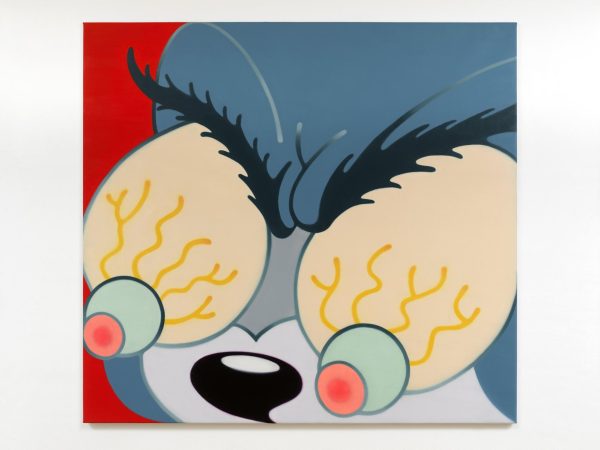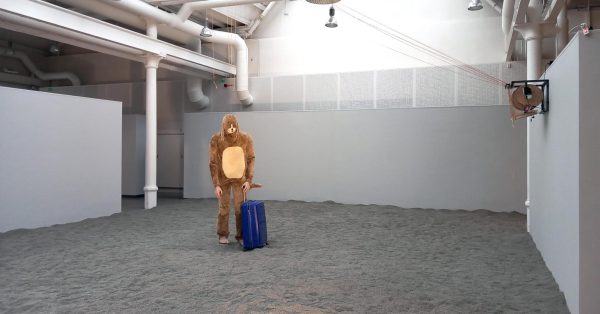“JonBenet Ramsey and the Culture of Child Abuse; Can We Clone Humans?” “Who Speaks for Kids? As growing up in America grows more perilous, the battle heats up over how best to help our children.” “Kids without a Conscience? Rape, murder, a baby dead at a prom: A look at young lives that seem to have gone very, very wrong.” “Too Fat? Too Thin? How media images of celebrities teach kids to hate their bodies.”
Curator Jean Crutchfield cited these headlines in her introduction to “Presumed Innocence,” a 1998 exhibition examining changing structures of childhood and adolescence in the late twentieth century in relation to television’s exposure to war, violence and cultural anxieties. The longstanding, mistaken presumption of childhood innocence is undermined by a group of conceptual artists such as Mike Kelley, Lisa Yuskavage and Inez van Lamsweerde. Within the exhibition, they acknowledge the agency, frustration and potential violence of children — deconstructing stuffed toys, re-appropriating the supposed naivete of cartoons and cyberizing childlike forms. Childhood, according to “Presumed Innocence,” is endangered by perilous social and cultural conditions.
In a feedback loop of exposure and self-reproduction, when do children stop being innocent and instead start being complicit in childhood’s demise?
In the 1990s, various artists explored how childhood’s supposed innocence is further destabilized by access to knowledge through television, media and digital structures that children are not cognitively able to process. Notable examples include “Kylie” (1997) by Dinos & Jake Chapman, “Glock” (1994) by Daniel Oates and “Pinocchio Pipenose Household Dilemma” (1994) by Paul McCarthy. Technologies are not innocent in exploiting the image of the prepubescent child in selling youth culture, or even in contributing to a 41% increase in violence on television between 1992 and 1994, as noted by Hillary Clinton in her book “It Takes a Village: And Other Lessons Children Teach Us.”
The mirror, a foundational object for children’s construction of the self, is replaced by the television; children mimic the chaos inside, seeing their reflection overlay a diet pill advertisement or live war footage from Afghanistan. In a feedback loop of exposure and self-reproduction, when do children stop being innocent and instead start being complicit in childhood’s demise?
“Ah, youth! Third graders smoke pot. Teenagers are covered with tattoos and piercings and brandings and body cuttings. Girls starve themselves to look sexy. Gangs recruit eight-year-olds to run drugs … Children are born into a world full of crack babies, drive-by shootings, AIDS, horrible pollution, congestion, fierce competition, no jobs, no hope, no guarantees, no future,” wrote Kathryn Hixson in her 1998 essay “Youthful Hysteria and Wild-eyed Delirium: Youth Culture Fights Back,” included in the exhibition’s publication. Margaret Mead noted in her 1970 “Culture and Commitment: A Study of the Generation Gap” that “there are now no elders who know more than the young themselves about what the young are experiencing.” Philosopher Theodor Adorno’s theory of “well-informed superiority” applies well here, in which seemingly informed people underestimate the powers they are up against. At the time of its inauguration 27 years ago, “Presumed Innocence” examined the dire nature of social death, its impact on children who adopt and perpetuate it and a thinning generational gap in which parents and children alike become ill-equipped to process a fragmented culture.
Since then, post-9/11 and contemporary art production has similarly dealt with the disturbing abyss of the digital age, now manifested in brain-rotted virtual realities, 4Chan and deep-web manospheres. The iPhone has replaced the television as a mirror, pressed up against the faces of young teens hidden under their bedsheets late into the night. Anxiety is revealed by contemporary art in the deconstruction of a hyper-sexualized, exploitative and pornographic self-image.
The landscape of violence in contemporary art is also different, set against the cultural backdrop of Columbine, the murder of Tamir Rice and Trump’s rise to power. Abjection, coined by Julia Kristeva in her book “Powers of Horror,” refers to the rejection of parts of the self that one finds particularly disturbing. Much of contemporary art since 2000 has dealt with abjection: the dispelling of horror manifested in childhood via trauma, digital indoctrination or exposure to violence which one cannot truly separate from itself.
Bernadette Corporation’s “Get Rid of Yourself” from 2003 examines the “aesthetics of rebellion” in a post-9/11, anti-art, anarchic landscape. The hour-long “antidocumentary” tracks the experiences of rioters from the 2001 G8 summit in Genoa, Italy, converging with digitally distorted footage of 9/11, pointing to the disturbance of civil life due to the pressures of capitalism and the subordination of the poor. In evidencing the leering presence of local and transnational empires and colonization, “Get Rid of Yourself” presents a strata of naturalized violence exacerbated by 9/11 which seeps into daily life and coming of age.

Children, victims of exposure to trauma detailed in “Get Rid of Yourself,” at some point become capable of enacting such violence. As perpetrators, children act out fantasies of social disintegration manifested through their screens. In Bunny Rogers’ “Mandy’s Piano Solo in Columbine Cafeteria” (2016), digital snow flecks accumulate on the floor of a virtual rendering of the Columbine High School’s cafeteria, where in 1999 students Eric Harris and Dylan Klebold massacred fifteen students and then themselves. Mandy, Rogers’ recurring digital character, melancholically sips red wine on the bench of a grand piano as her spindly, triangular fingers brush up and down the keys.
Johanna Fateman refers to the Columbine shooting in her review of Rogers’ work in Artforum as a “fin-de-millennium media event that produced shocking new icons of alienated masculinity and remapped the American high school as a site of spectacular violence.” “Mandy’s Piano Solo in Columbine Cafeteria” also contributes to new icons in the post-9/11 era of artistic production in its ominous liminality. The cafeteria, a space designated for children, becomes the uncanny animated detritus of societal collapse as digital pixels converge to reflect an early 2000s tech aesthetic.
Much of contemporary art since 2000 has dealt with abjection: the dispelling of horror manifested in childhood via trauma, digital indoctrination or exposure to violence which one cannot truly separate from itself.
Ben Davis typifies this post-9/11 aesthetic in his essay “Culture Has No Name for this Cursed Vibe. It’s Everywhere,” and writes that the ill-defined movement, which has extended until the present, displays “the sense of a digital reality-collapse that is now accelerating faster and faster … (present in) the dark feeling I get from the story of the young man who tragically took his own life because his A.I. clone of ‘Danaerys’ from “Game of Thrones” told him to ‘come home.’ … It’s the influencers literally eating themselves to death on camera.” This brings to mind the 2014 stabbing in Waukesha, Wisconsin, in which two teens, after spiraling into the Creepypasta web page, stabbed their friend in the woods to appease the fictional video game character Slender Man.
The agency of the child is then questioned. As adults “fear the children we would protect,” their power as perpetrators of violence is realized. Conversely, Hong Kong’s “Chalk Girl,” a fifteen-year-old arrested in 2014 for drawing flowers in chalk on a government building, became an icon of the Umbrella Movement and children’s political rebellion. Children like “Chalk Girl,” symbols of childhood purity, double as undisciplined resistors.

Anna Uddenberg’s “Closing” (2022) examines babyhood and agency as much as it discusses the liminal deconstruction of self-image. A man dressed in a diaper and crocs suggestively crouches, backside to the sky, within a sterilized bassinet doubling as a suitcase. Constrained and molded within a sickly sweet blue and gray contraption, complete with leather frills on its hinges, the man-as-baby is subject to the space around him. Suggesting a subliminal desire to reconnect with intrauterine existence as detailed by Paul Federn’s “Womb Fantasy,” the man is received by a womb-like machine, thereby giving up his own agency.
The work engineers his posturing, referencing a pornographic self-image, and alludes to the sexual development of children we would rather not talk about, which Freud did, extensively. Once more returning to Kristeva’s theory of abjection and Lacan’s theory of a child’s “mirror stage,” Robert Hobbs writes in his essay “Youth’s Purgatory” that “Kristeva’s … insidious oedipal narrative characterizes a recurrent … pattern in which one rejects aspects of oneself … in order to come to terms with the symbolic name-of-the-father.” Uddenberg’s sculpture welcomes and disgusts the man which it encapsulates because it reveals his internal desire to reject the self and become one again with the parent and womb.

Gowoon Lee explores the underpinnings of violence and sexuality in Mickey Mouse, Looney Tunes and other early children’s cartoons that subsume modern relevance. In “Asphyxia,” (2022) Lee titillates sexual euphemisms by cornering the exaggerated, bulging eyes of Tom from Tom and Jerry. Intensely furrowed eyebrows constrict bulbous forms, referencing adult anatomy. Upon a searing red backdrop, Tom grotesquely transforms into a veiny, aggressive icon while Lee maintains a familiar cartoon-ish painterly aesthetic. As Lee imbues aggression and suggested sexuality into antiquated children’s imagery, the gap between the dawn of television and the weird, web-ish fissures children and teenagers subscribe to is illuminated.
Works like Leila Hekmat’s 2022 play “CROCOPAZZO!” explore sexually charged family dysfunction, while Stanya Kahn’s “Stand in the Stream,” produced from 2011-2017, documents interactions with strangers on Omegle. Colin Montgomery’s “Emergency Doors (Smithsonian American History Museum)” from 2006 implies violence towards school group tours, imposing the conditional usage of emergency doors. Tobias Bradford’s “Hundis” comes to mind as reflective of the post-9/11 aesthetic, as a nightmarish presentation of an animatronic dog-man who appeared in the artist’s dreams as a child.

On the back of the AIDS crisis and early 90s retro technology, “Presumed Innocence” reflected systems of childhood withering throughout the twentieth century. In post-9/11 artistic production, the idyllicism of childhood is further deconstructed. Out of red-pilled male supremacy, right-wing extremism, QAnon, Slender Man and Elon Musk’s DOGE coin, the art of abjection is produced — grotesque, self (and society) repellant and liminal. It is a result of the horrifying realization that kids kill each other, police brutality footage is streamed on YouTube and the Nazi party is being reimagined before our eyes. The worst part is, that we all belong to a culture which allows it. Therefore, the post-9/11 and contemporary aesthetic negates the innocence of children and adults alike, repelling manifestations of societal evil upon art objects. We watch, stare and shiver at how much these art objects look just like us.

